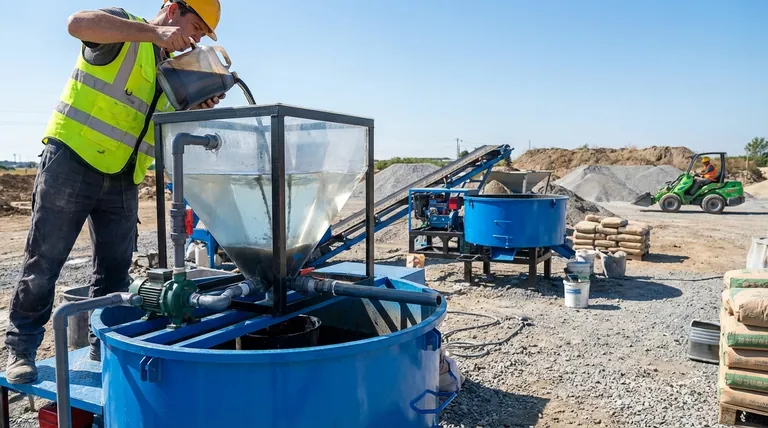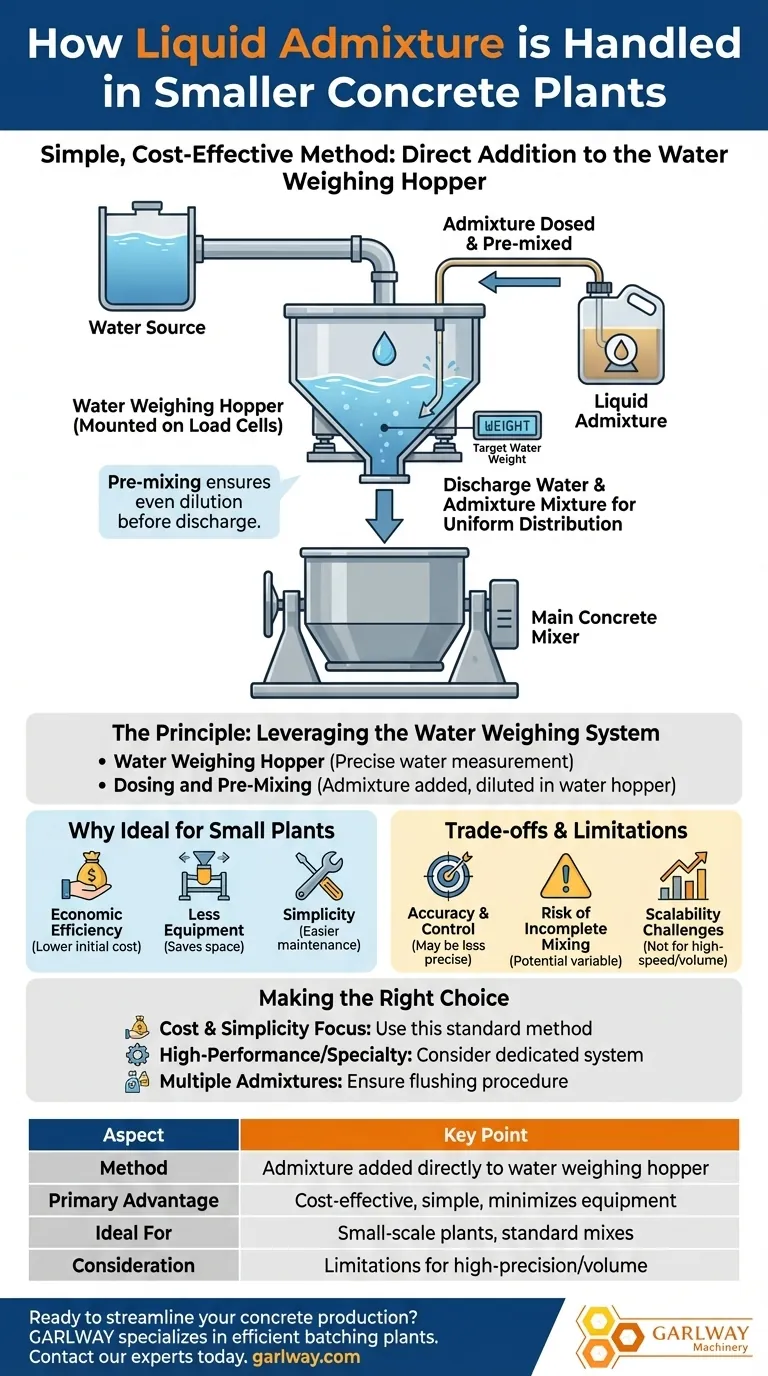In smaller production capacity concrete plants, the liquid admixture is typically handled by adding it directly into the water weighing hopper. This simple and cost-effective method allows the admixture to be pre-mixed with the measured batch water before both are discharged into the main concrete mixer.
The core strategy for small plants is efficiency and simplicity. By integrating the admixture dosing into the existing water weighing system, operations can minimize equipment costs, reduce plant complexity, and maintain a streamlined production workflow suitable for lower-volume output.

The Principle: Leveraging the Water Weighing System
In any concrete plant, water must be accurately weighed for each batch. Smaller plants capitalize on this existing piece of equipment—the water weighing hopper—by giving it a dual purpose.
What is a Water Weighing Hopper?
A water weighing hopper is essentially a container mounted on load cells. Its primary job is to precisely weigh the required amount of water for a specific concrete mix design before it's introduced into the mixer.
The Dosing and Pre-Mixing Process
The process is straightforward. First, the target amount of water is weighed in the hopper. Then, the liquid admixture is dosed into that same hopper.
This pre-mixing ensures the admixture is evenly diluted within the batch water. When the hopper discharges, the water and admixture are introduced into the main mixer together, promoting a more uniform distribution throughout the concrete.
Why This Method is Ideal for Small Plants
This approach is dominant in smaller operations primarily due to its economic and operational efficiency. It eliminates the need for a separate, dedicated weighing system for admixtures, which reduces initial capital investment, saves physical space, and simplifies the plant's control system and overall maintenance.
Understanding the Trade-offs and Limitations
While effective, this method has considerations that are important to understand, especially when compared to the dedicated systems found in larger, high-volume plants.
Accuracy and Control
The precision of this method is dependent on how the admixture is added to the water hopper. While the water is weighed, the admixture itself might be dosed by a timed pump or a flow meter, which can be less accurate than a dedicated admixture weighing system. This is generally acceptable for standard concrete but might be a limitation for highly sensitive, specification-critical mixes.
Risk of Incomplete Mixing
If the admixture is added to a still tank of water without sufficient agitation, it may not fully disperse before being discharged. The turbulence created during the discharge process often mitigates this, but it remains a potential variable.
Scalability Challenges
This method is not ideal for high-speed, large-volume production. Larger plants require dedicated admixture weighing and delivery systems to keep pace with rapid batching cycles and ensure the highest degree of accuracy for every single load.
Making the Right Choice for Your Operation
The decision to use this method or invest in a more complex system depends entirely on your production goals.
- If your primary focus is cost-effectiveness and operational simplicity: Pre-mixing in the water hopper is the industry-standard and most logical solution for a small-scale plant.
- If your primary focus is producing high-performance or specialty concrete: You may need to invest in a separate, high-precision admixture dosing system to meet strict quality control standards.
- If you frequently switch between different types of admixtures: Ensure you have a clear procedure for flushing the water hopper between batches to prevent cross-contamination.
Ultimately, integrating admixture dosing with the water system is a smart, efficient solution that enables smaller plants to produce quality concrete without unnecessary complexity.
Summary Table:
| Aspect | Key Point |
|---|---|
| Method | Admixture is added directly to the water weighing hopper. |
| Primary Advantage | Cost-effective, simple, and minimizes equipment needs. |
| Ideal For | Small-scale plants focused on standard concrete mixes. |
| Consideration | May have limitations for high-precision or high-volume production. |
Ready to streamline your concrete production?
At GARLWAY, we specialize in designing and supplying efficient concrete batching plants and mixers for construction companies and contractors. Our solutions are engineered to deliver the perfect balance of simplicity, reliability, and cost-effectiveness for your smaller-scale operations.
Contact our experts today to discuss how we can help you optimize your admixture handling and overall production workflow.
Visual Guide

Related Products
- Ready Mixer Machine for Construction Ready Mix Machinery
- Commercial Construction Mixer Machine for Soil Cement Mixing Concrete
- Hydraulic Concrete Mixer Machine Cement Mixing Equipment for Mixture Concrete
- Portable Concrete Mixer Machine Equipment for Mixing Concrete
People Also Ask
- What is the average lifespan of a concrete mixer? Maximize Your Equipment's Lifespan & ROI
- When was the first concrete mixer developed and by whom? Discover the 1900 Breakthrough
- Why is cleaning a concrete mixer after use important? Avoid Costly Repairs and Ensure Quality
- Why is the manufacturer's strength and service important when choosing a concrete mixer? Ensure Long-Term Project Success
- What safety considerations are important for concrete mixer operation? A Guide to Proactive Risk Management



